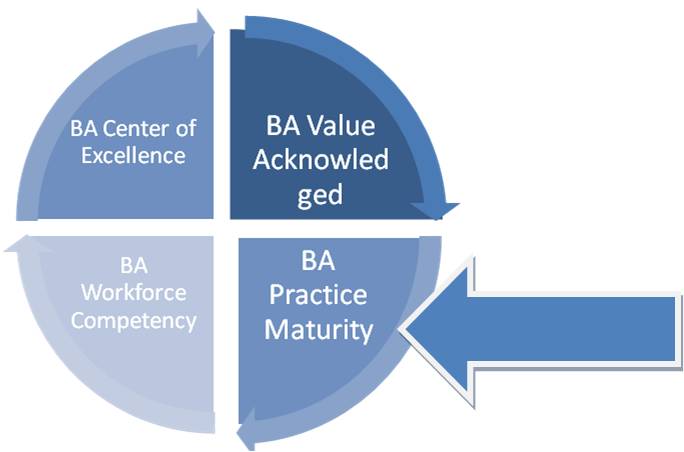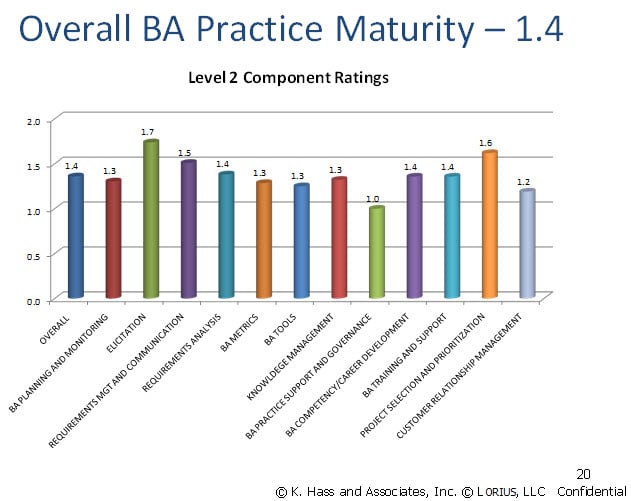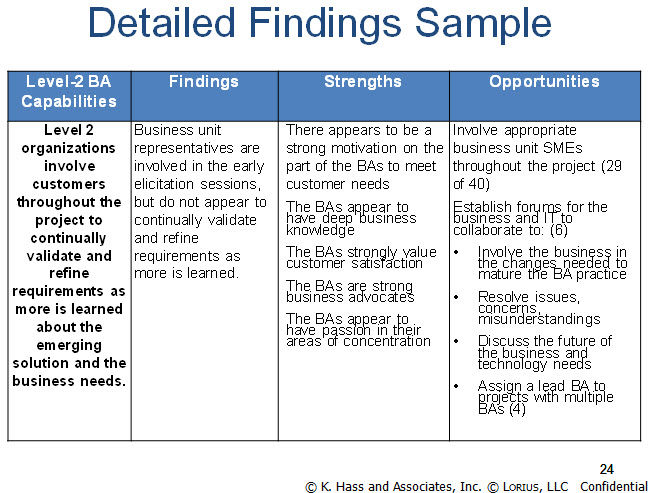NOTE: This article is part of "The 21st Century BA Series: From Tactical Requirements Manager to Creative Leader of Innovative Change"
As businesses acknowledge the value of business analysis – the result of the absolute necessity to drive business results through projects – they are struggling to figure out three things:
-
What are the characteristics of their current BA workforce, and how capable does their BA team need to be?
-
What is needed to build a mature BA Practice?
-
How are we going to get there?
This article focuses on #2: What is needed to build a mature BA Practice? See Exhibit 1: BA Practice Maturity Framework. Key concepts include:
In previous articles we introduced the comprehensive BA Practice Maturity Framework. The journey begins with an acknowledgement that business analysis is a critical business management discipline for the 21st century. Realizing that it takes investment and resources to build a new business management practice, our framework calls for a proven, structured approach coupled with expert change management skills. Our framework involves a three-pronged approach to build a mature BA Practice, develop a competent BA workforce, and establish a BACOE to plant the seeds and steer the course. This chapter focuses on building a mature innovation-driven BA Practice.

Exhibit 1: BA Practice Maturity Framework
Mature Busienss Analysis Practices
To steer the course, we once again make use of a model, the BA Practice Maturity Model (Exhibit 2). As you can see, the model is in strict alignment with the BA Individual and Workforce Capability Model introduced previously.

Exhibit 2: BA Practice Maturity Model
The maturity levels of the BA Practice Maturity Model are described below (Exhibit 3).
| Level |
Description |
Level 4:
Business Technology Optimization
|
Business Benefit: Technology is Used as a Competitive Advantage
Organizations at Level 4 recognize that advanced business analysis practices are needed to innovate and use technology as a competitive advantage. Level 4 organizations vest accountability for business/technology optimization in a centralized organization that represents the entire enterprise that is responsible for management of the business/technology optimization practices. Specifically, to achieve Level 4:
-
The enterprise BACOE is integrated with other centers of excellence (project management (PM), quality assurance (QA), software architecture and engineering (SE) and manages the vision, goals, objectives, and plans to achieve business/technology optimization
-
The following process and tools are developed, piloted, deployed, and institutionalized:
• Convert business opportunities into innovative new business solutions
• Strategy development and translation into breakthrough process and technology change
• Customer Relationship Management
• Organizational Readiness Assessments
• Organizational Change Management
-
Quantitative BA Process Management Program Integrated with PM, QA, SE
-
A Level 4 Training Program is developed and required
|
Level 3:
Business Alignment
|
Business Benefit: New Business Solutions Meet Business Need; Strategy is Executed
Organizations at Level 3 recognize that business analysis is essential to ensure business alignment of project goals, objectives, and the new business solutions deployed by the project teams. Level 3 organizations vest accountability for business alignment in a centralized organization that represents the entire enterprise and is responsible for management of the business alignment practices. Specifically, to achieve Level 3:
-
The BACOE mission is the centralized management of resources, contractors, vendors
-
The following process and tools for achieving business alignment are developed, piloted, deployed, and institutionalized:
• Enterprise Analysis
• Portfolio Management
• Strategic alignment of project investments
• Solution assessment and validation
• Benefits measurement program
|
Level 2:
BA Framework |
Business Benefit: Business Requirements are Managed and Business Objectives are met
Organizations at Level 2 recognize that business analysis is a valuable capability by vesting accountability for it in a centralized organization that represents the entire enterprise and is responsible for the management of the BA Project Framework. The organization, often referred to as the business analysis center of excellence (BACOE), assigns roles and responsibilities and establishes plans for developing, piloting, and deploying BA standard requirements management practices. Specifically, to achieve Level 2:
-
The BACOE is established and roles and responsibilities assigned to develop and manage the BA Framework
-
The following process and tools for managing project requirements are developed, piloted, deployed, and institutionalized:
• BA Planning and Managing
• Requirements Elicitation
• Requirements Management and Communication
• Requirements Analysis
• Requirements defect prevention
-
The knowledge management process and system is developed and is in place to archive, manage changes, and provide appropriate access to all BA process and tool assets and actual BA artifacts
-
A Level 2 Training Program is developed and required
|
Level 1:
BA Awareness |
Business Benefit: Business Analysis Value is Acknowledged
At Level 1, an organization does not have plans to implement a business analysis practice, or it has plans, but they do not yet demonstrate an understanding of the value of business analysis
|
Exhibit 3: BA Maturity Model Description
The Daunting Road Ahead
As you can see in Exhibit 4, there are many elements that need to be in place to implement a mature BA Practice. So, it begs the question: how are we every going to get there, and how fast can we get there?
| Mature Practices |
Proactive Environment |
Effective BA Workforce |
Business Focus |
| Standards & Tools |
BACOE |
Competent BAs |
Enterprise Analysis |
| Metrics & Measurements |
BA Governance |
BA Role Definition & Career Path Leading to VP BA |
Customer Relationships |
| Continuous Improvement |
Periodic Maturity Assessments |
Mentoring Program |
Business Benefit Management |
| Knowledge Management |
Periodic BA Workforce Assessments |
Robust Training Program |
Competitive & Feasibility Studies |
Exhibit 4: Building Blocks of a BA Mature Practice
Cultivating Mature Business Analysis Practices
A BA Practice Maturity Assessment Process and Practice Improvement Program are essential tools used to build a mature BA Practice. Together, they provide validated, accurate information about the current state of BA practices, accompanied by recommendations for improvement and support along the journey. In addition, the assessment determines the readiness of the organization to accept and support the new BA practices and formation of a BA Center of Excellence to plant the seeds and steer the course. Specifically, the assessments:
-
Measure the ability of your organization to repeatedly deliver new business solutions that meet the business need and result in the expected benefits
-
Provide a foundation and guidance for advancement of practices through prioritized, sequential improvements
-
Provide an indicator of how effective your organization is in meeting business objectives and executing strategy through successful implementation of new business solutions
Business Analysis Practice Maturity Assessment
Assessment Components
The scope of the assessment needs to be broad, encompassing the following components:
-
BABOK® Standards: BA Planning & Monitoring, Elicitation, Requirements Management, Enterprise Analysis, etc.
-
BA Metrics
-
BA Tools
-
Knowledge Management
-
BA Practice Support & Governance
-
Change Management
-
BA Competency & Career Management
-
BA Training & Support
-
Project Selection & Prioritization
-
Customer Relationship Management
-
BA Center of Excellence Effectiveness
Assessment Approach
The approach to conducting an organizational maturity assessment can be formal or informal. In either case, it is multi-dimensional, and includes planning meetings culminating in a kick-off session, administration of an assessment instrument, review of project artifacts and deliverables, accompanied by a series of interviews and focus group sessions. Information is synthesized, organized, validated and documented in a data summary report and an assessment findings and recommendations report containing a two-year roadmap and action plan for immediate next steps.
Formal or Informal Assessments
The BA Practice Maturity Model can be used as the basis for several types of assessments as described in the table below (Exhibit 5). Depending on how far you have come in your journey to cultivate mature BA practices, we recommend the most appropriate evaluation of your BA Practice.
| Quick Practice Evaluation |
Abbreviated Assessment |
Full Assessment |
| Questionnaire Administration |
Questionnaire Administration |
Questionnaire Administration |
| 5 Interviews |
5 Interviews
2 Focus Groups
3 Projects Reviewed
|
10 Interviews
4 Focus Groups
5 Projects Reviewed
|
| Kickoff and Findings Presentations |
Kickoff and Findings Presentations |
Kickoff and Findings Presentations |
| Data Summary Report |
Data Summary Report |
Data Summary Report |
| |
Findings and Recommendations Report |
Findings and Recommendations Report |
| 1 Assessor |
2 Assessors |
2 Assessors |
| 1-2 Weeks |
2-3 Weeks |
3-4 Weeks |
Exhibit 5: BA Maturity Assessment Options
Assessment Deliverables
There are two key assessment deliverables:
o Overall Maturity Rating
o Maturity Rating for each component
o Strengths
o Opportunities
o Detailed findings
o Detailed recommendations
o Roadmap to close the gaps
o Action plan to implement recommendations
Sample Assessment Results


Look for Next Month’s Article: Fostering Team Creativity: The Business Analyst’s Sweet Spot
 The articles in this series are adapted with permission from The Enterprise Business Analyst: Developing Creative Solutions to Complex Business Problems by Kathleen B. Hass, PMP. © 2011 by Management Concepts, Inc. All rights reserved. The Enterprise Business Analyst: Developing Creative Solutions to Complex Business Problems
The articles in this series are adapted with permission from The Enterprise Business Analyst: Developing Creative Solutions to Complex Business Problems by Kathleen B. Hass, PMP. © 2011 by Management Concepts, Inc. All rights reserved. The Enterprise Business Analyst: Developing Creative Solutions to Complex Business Problems
%20Hass.jpg) Author: Kathleen B. (Kitty) Hass, PMP, Senior Practice Consultant, Kathleen Hass & Associates, Inc.
Author: Kathleen B. (Kitty) Hass, PMP, Senior Practice Consultant, Kathleen Hass & Associates, Inc.
Kitty is the president of her consulting practice specializing in enterprise business analysis, complex project management, and strategy execution. She is a prominent presenter at industry conferences, author and facilitator. Her BA Assessment Practice is the gold standard in the industry. KHass BA Assessments:
-
Appraise both BA organizational maturity and individual/workforce BA capability based on four-stage reference models
-
Present results that are continuously examined for reliability and validity by Lori Lindbergh, PhD, Senior Researcher and Psychometrician , LORIUS, LLC
-
Benchmark results against a global data base of BAs performing comparable work
-
Align with the IIBA BABOK® and the BA Competency Model®
-
Align with standards and best practices for quality and fairness in educational and psychological assessment
-
Are based on the skills and knowledge needed to work successfully on the complexity of current project assignments
-
Examine critical relationships between competency, project complexity, and project outcomes.
In addition to assessments, Kitty’s expertise includes implementing and managing PMOs and BACOEs. She has over 25 years of experience providing professional services to Federal agencies, the intelligence community, and Fortune 500 companies. Kitty is a Director on the IIBA Board and Chair of the IIBA Board Nominations Committee. She has also authored numerous white papers and articles on leading-edge business practices, the renowned series entitled, Business Analysis Essential Library, and the PMI Book of the Year, Managing Project Complexity - A New Model.
Email: [email protected]
Website: www.kathleenhass.com
Blog: http://baassessmentmatters.blogspot.com/
Twitter: @BA_Assessment @KathleenHass1